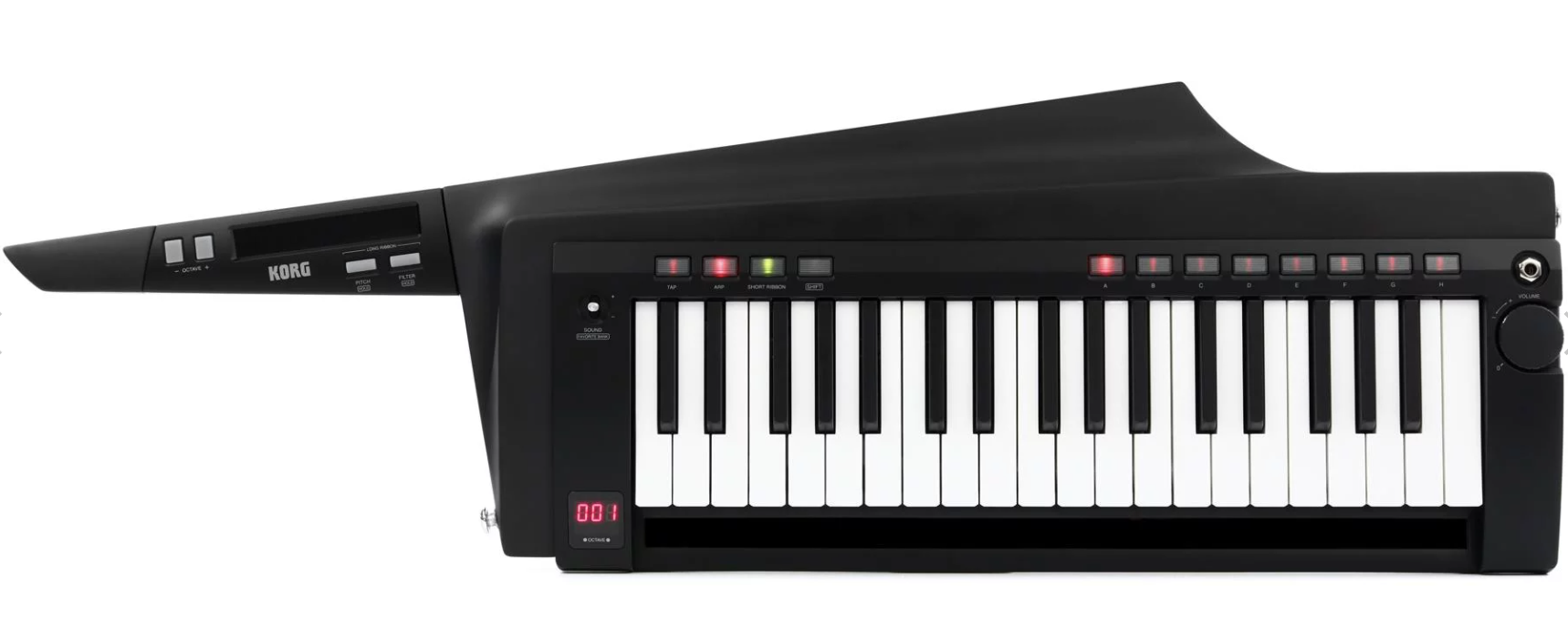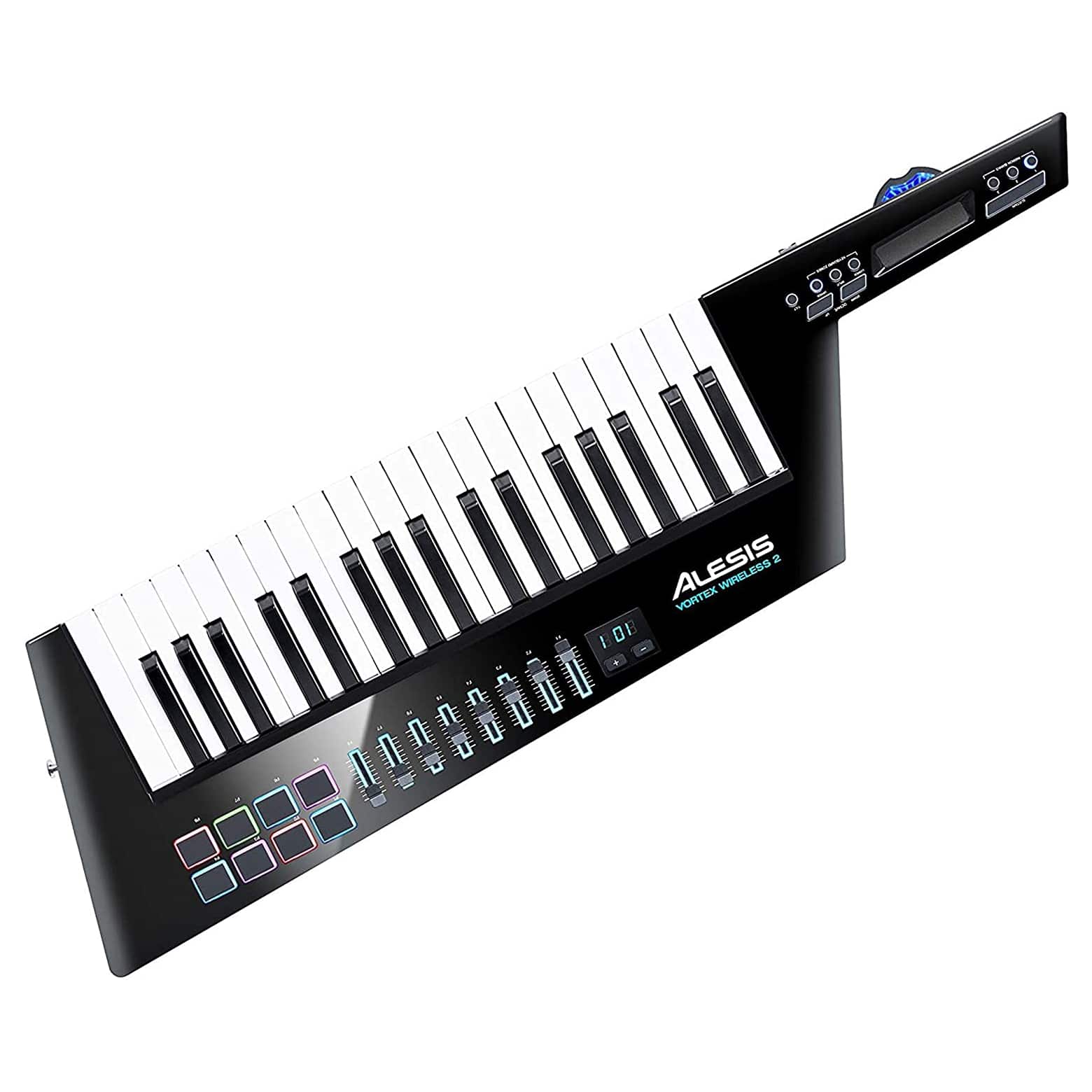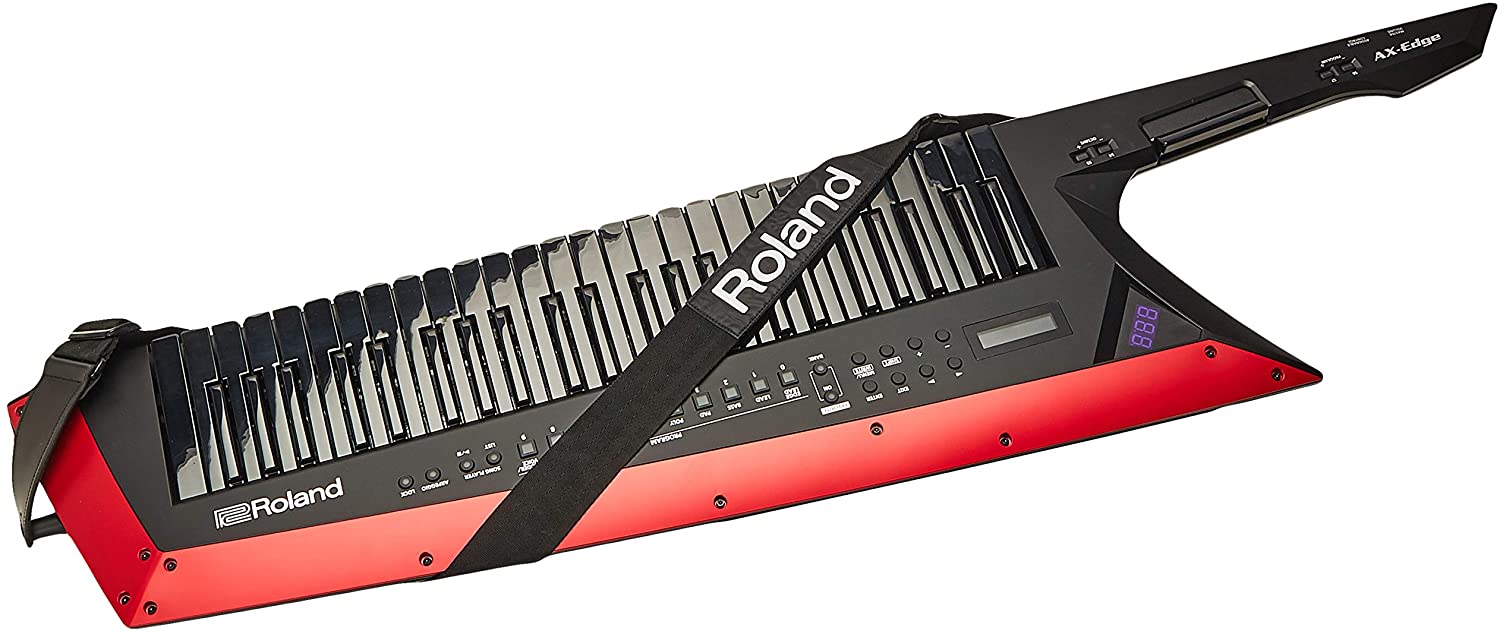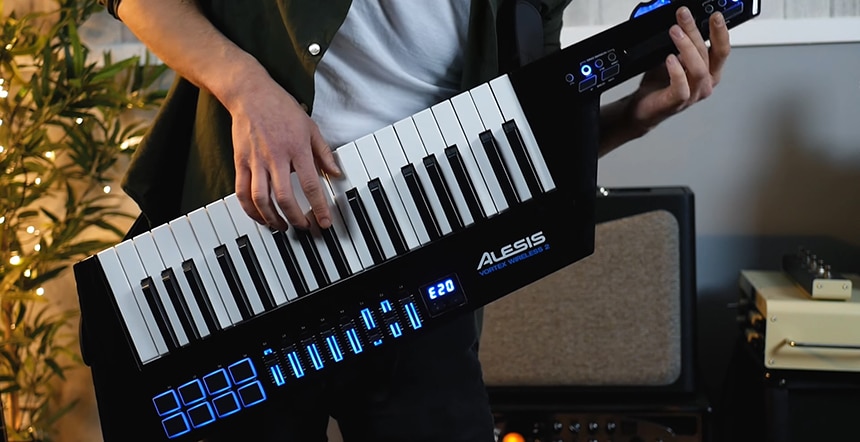
Although not as common nowadays as in the 70s, keytars are still quite relevant as musical instruments. With a wireless and battery-powered keytar, you can perform pretty much anywhere whether indoors or outdoors, and still get similar sound output as a regular keyboard. This fun mashup of the keyboard and guitar performs the freedom to move around and be more expressive while performing.




Modern keytars are versatile musical instruments, and there are several options if you are considering buying one. Here's a review of the best keytars on the market. You could get a full MIDI controller like the Alesis Vortex Wireless II or a synthesizer complete with voices and sound effects like the Roland AX-Edge or the Yamaha Sonogenic. In this review, we have considered the features of each of these keytars to help you determine which of them will be the right fit for you based on your skill level, personal preference, and performance requirements.
| № | Name | Rating | |
|---|---|---|---|
| 1 | Alesis Vortex Wireless 2 |
9,7
|
Check price |
| 2 | Roland AX-Edge |
9,5
|
Check price |
| 3 | Korg RK-100S |
9,3
|
Check price |
| 4 | Yamaha Sonogenic Mini |
8,5
|
Check price |
| 5 | Yamaha Sonogenic |
9,2
|
Check price |
Other features: USB, included software, MIDI

Coming in at just 6.5lbs, the Alesis Vortex is a portable wireless Keytar. Despite the lightweight build, this keytar does not feel flimsy at all. It is quite durable, and anyone looking to do gigs frequently with a keytar will find the Vortex 2 a suitable fit for them. It features 37 full-size keys that offer a complete melodic range and 8 trigger pads for creating beats, and 8 faders to control volume and other virtual parameters.
The Alesis Vortex 2 is quite similar to its predecessor, the popular Alesis Vortex. The original Vortex was a first of its kind because it was the first keytar without internal sounds. This unit is a MIDI controller as well. However, the Vortex 2 improves some of the features of its predecessor though the two have a similar layout, size, and design. One of the main distinctions between the two is the 8 backlit RGB MIDI drum pads on the Vortex two. We fund this as a major improvement, especially for those who want to use the keytar for live performance.
Other features: 70 types of part multi-effects, 320 programs, 500 preset tones

The Roland Ax-Edge is a solid performance keytar made by one of the biggest names in the market. This instrument incorporates great MIDI functionality with brilliant new sounds, which makes the keytar quite versatile. With up to 49 full-sized keys, over 500 preset sounds, and more than 79 sound effects, there is no doubt that this instrument is built for serious players.
This Roland Ax Edge is a reboot of the original Ax keytar, which was popular in its heydays. The instrument is Roland’s response to Alesis Vortex 2, and it matches up to it pretty well both in terms of performance and functionality. The Roland AX-edge has a sleek design which makes it even cooler than its predecessor. Unlike other keytars that feature a traditional 37-key design, this one has 49 keys, one of its main distinctions.
Other features: 8-note polyphonic, 200 stage-ready presets, software bundle

The Korg RK-100S is a rebirth of the once-popular RK-100 remote controller that was loved by many for its features that allowed a keyboard player to challenge the vocalist or guitarist. The Korg RK-100S has more beautifully curved surfaces and is a tad smaller and lighter. However, the essence of the original design of the RK-100 is pretty much unchanged. The modern components of a keyboard are the primary reason for the reduced size and weight. Also, the original could not be played without an external sound module but the Korg RK-100S has a built-in analog modeling sound generator. Other new features and functions of the Korg RK-100S include; a ‘favorite’ button that gives you a one-touch selection for all your frequently used sounds.
The built-in sound generator makes life easier as you can perform by simply connecting an audio cable. Also, besides providing standard analog synthesizers like Sawtooth and Square, the built-in sound engine provides additional oscillator algorithms like noise, PCM and format waveforms. The additional algorithms can power up two hundred preset programs for a wide range of sounds that can cover virtually all music genres. What’s more, you can play these sounds with an arpeggiator. In a nutshell, the Korg RK-100S is a fantastic keyboard for a smarter, more enjoyable, active playing style considering it comes with two ribbon controllers, and it is small, yet it offers amazing playability.
Other features: 12 voices (4 voices categories with 3 variations), JAM function mode, USB, built-in speaker

If you’re looking for a simple Keytar for beginners, the Yamaha Sonogenic Mini is one of the best options to consider. While it is smaller than your average instrument, it still features loads of options, making it ideal for beginners and serious players alike. The instrument weighs about 3.5 pounds and has a very slim design which will come in handy if you spend a lot of time traveling.
The Yamaha Sonogenic Mini has USB MIDI capabilities. This means you can make music with this keytar using soft synths and DAWs. Although it is advertised as a Keytar for those who have never played one before, it comes with advanced features such as tune adjustments, transpose, and octaves, just like any other pro-level synth out there.
Other features: Bluetooth MIDI, USB, wireless IOS connectivity

This Yamaha Sonogenic keytar is an ultra-lightweight instrument built for those searching for a simple and easy-to-use synth keytar for play and serious performance alike. It can be connected to an external PA with 1/4″ Aux jacks or played directly using the inbuilt speakers. Additional features like reverb, dynamics, and reverb are also on this portable keytar for those needing a robust instrument for performance.
The Yamaha SHS-500 is a higher-feature version of the SHS-300. While both are pretty much the same in terms of appearance and have the same number of keys, the mini is a bit more compact than this one. The keys are full-sized, which makes it more convenient compared to the smaller Sonogenic.
Musicians who prefer to switch things up a bit by moving around during their performance will find this instrument quite impressive. However, because keytars are not as popular as they used to be, choosing the right one for you can be challenging since most people don’t know a lot about them. There aren’t many options available, but there’s enough diversity to confuse anyone who does not know a lot about keytars. The following are some of the important considerations to keep in mind when shopping for a keytar.

As mentioned, not many people are familiar with Keytars Trusted Source A Brief History of the Keytar | Reverb News The much-maligned and ironically played instrument may be closely tied to the ’80s, but its roots go back further than you may think. reverb.com . So what exactly are they, and how do they work? A Keytar is a type of electronic musical instrument that looks like a guitar and a keyboard combined, hence the name. The keytar is carried by a strap the same way you would carry your guitar, but it has keys like a keyboard does.
It is believed that keytars were originally invented to give keyboard players some mobility while on stage and also encourage groupies. They can be powered directly by electricity, but most models include batteries that further improve their mobility. With a keytar, you will be able to set up and play anywhere to play without a stand (or even a power source).
Like any musical instrument, buying a keytar requires you to know some basic things. Even though a lot of available products offer similar features, there are some subtle distinctions between them. This section will go over some of the most important factors to consider in buying keytars.
Aside from features and components on the unit itself, you also have to consider your skill level in choosing a keytar and your purpose for buying it. Note that the best keytar on the market does not have to be the most feature-packed product. As long as it serves your purpose, you are good to go. The following are some of the basic factors to consider when buying a keytar.
Most keytars feature 37 keys. But there are some like the Roland AX-Edge that come with 42 velocity-sensitive keys. Of course, the more the keys, the higher the versatility of your keytar. However, most people are cool with a 37-key unit, and it serves their purpose sufficiently enough. However, even with units with the same number of keys, there are other qualities to look for pertaining to the keys. The key size, for instance, will determine how easy it will be to play the keytar. Instruments like the Yamaha Sonogenic Mini, for example, have 37 keys too. But they are not full size since the instrument is a mini keytar. You may find compact units like this a bit difficult to get used to, given their smaller dimension.
In the past, keytars used to be quite bulky despite the fact that they were meant to be carried with you while you performed. These days, they are now made with lighter hardware which means they are not as heavy as they used to be. Still, the weight may vary from one instrument to the other. If you are doing a lot of moving around on stage, you may want to consider a lightweight option like the Yamaha Sonogenic. The lightweight also makes it perfect for younger players who may struggle with bigger and bulkier instruments.

Most of the well-known brands make keytars that are made from durable plastic material. This is important since the type of material the instrument is made from will determine its durability. If you are moving around a lot with your instrument, you’ll want it to be made from quality material that can take some beating.
Check with the manufacturer or supplier you are buying from to ensure that a warranty covers your keytar. You should also confirm how long this warranty is and what type of repairs it covers. These conditions will vary from one brand to the other, so it makes perfect sense to confirm. While a warranty is not an absolute quality indicator, you will at least be certain you can return the instrument or get it repaired cheaply if there’s a fault.
The price of a keytar can vary significantly depending on the brand and type of the unit. You’ll be surprised that new keytars aren’t very expensive compared to the vintage ones. But you will spend more if you want to buy a vintage instrument.
If you’re going to purchase a keytar for performance, you might as well look for one that takes advantage of everything a keytar can do Trusted Source Hey, what's that sound: Keytar | Pop and rock | The Guardian The keytar has still never really rivalled the guitar in terms of what it can do for the sex-appeal of its wielder. www.theguardian.com . In addition to the basic features of the keytar that you should look out for, some extra features can help you determine whether or not to purchase a unit or not or make a decision between two quality instruments you are considering. Some of these features include

Extra components don’t make a world of difference when deciding to buy a keytar, so they’re not always a deal-breaker. However, having these components can help you save extra costs since you won’t have to buy them separately. Some of the extra components you may have on your keytar include
If your play the keyboard or piano already, you should have no trouble playing a keytar since half of the body of the keytar is a synthesizer keyboard. You can plug a keytar into any standard amplifier, but some units have an inbuilt speaker to play sound directly. To start playing, sling the keytar over your shoulder the same way you should do with a regular guitar and adjust the strap accordingly until your playing hand can conveniently reach the instrument’s keys.
Unlike a keyboard, you practice playing a keytar with just one hand, while the other hand can be used to adjust the controls on the other end of the instrument. It may take a while to get used to playing it one hand like this, especially if you’re already accustomed to playing the piano.
The Alesis Vortex Wireless 2 is our top pick for the best keytar on the market. This quality wireless keytar controller comes inbuilt with a professional software suite and pro tools, making it ideal for serious performers. The Roland AX-Edge is equally top-quality as well and ideal for beginners. It is quite similar in features to the Vortex 2 but comes with 49 keys instead of the traditional 37 that you’ll find on most units.
We also recommend the Yamaha Sonogenic Mini and Yamaha Sonogenic as the best keytar for beginners. If you’re new to playing keyboards or keytar and you’re looking for an affordable option, either of these two would work great.
Whether you simply like the idea of owning a keytar for personal entertainment at home or you are a serious performer in need of a good quality performance keytar, the products covered in this review are some of the best keytars on the market that you should consider.